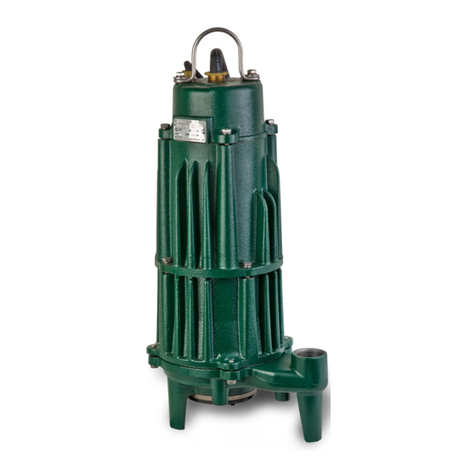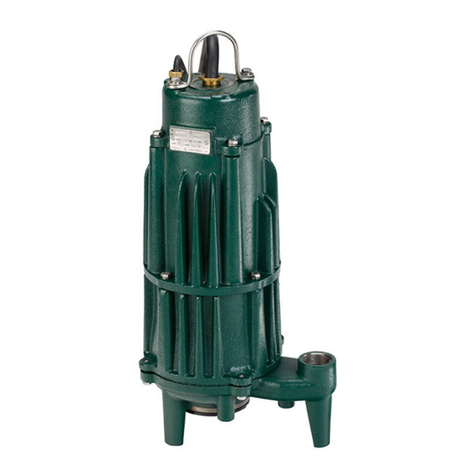
4
© Copyright 2020 Zoeller®Co. All rights reserved.
Disassembly Procedures
DISASSEMBLY PROCEDURES
A. Before you begin...
1. Shut off pump.
2. Disconnect power source.
3. Remove pump from system.
B. When removing cutter (30)...
1. Complete Section A.
2. Immobilize the cutter (30) by placing an brass or aluminum rod in one of
the holes in the cutter plate (29). Turn the cutter until it is against the rod
in the correct direction to remove the cutter screw (34).
NOTE: It may be necessary to heat the hex head screw with a propane torch
to soften the thread compound.
Do not chip or nick the cutter while using the rod to immobilize
the cutter.
3. Using a socket remove the cutter screw (34) and washers (33) (32).
4. Remove the cutter (30).
5. Remove the cutter shims (25).
NOTE: Count the number of shims removed so the same number and sizes
can be installed upon reassembly.
C. When removing cutter plate (29)
1. Complete section A and B.
2. Remove the eight cutter plate screws (31) and remove the cutter plate
(29).
D. When removing impeller (26)...
1. Complete Sections A and B.
2. Remove four screws (40) and lockwashers (3) from pump housing (28).
3. Remove pump housing (28) and gasket (27) from adapter housing (19).
4. Using two pry bars, carefully pry the impeller (26) from the shaft.
5. Remove the impeller shims (25).
NOTE: Count the number of shims removed so the same number and sizes
can be installed upon reassembly.
6. Remove the square key (15) from the shaft.
E. When removing rotary seals (20 & 24)...
1. Complete Sections A, B and D.
Pump should be at room temperature. Seal and motor housing
may be pressurized. Care should be used in removing pipe plugs (1) so
that oil is not sprayed.
Do nottouchsealing faceof therotating sectionor thestationary
section of the rotary seal (20 & 24) when removing or installing seal. When
seal replacement should be done in shop atmosphere if possible.
2. Remove lower snap ring (21) from shaft.
3. Remove the spring holder and seal spring of the lower rotary seal (24)
from the shaft. See rotary seal component placement diagram for part
identication.
4. Remove the pipe plug (1) in the side of the adapter (19) and drain the oil
from the chamber with the pump laying on it’s side.
5. Remove the four socket head screws (22) from the seal retainer (23).
6. Use two screw drivers to lightly pry the seal retainer (23) from
the adapter (19). The remaining parts of the lower seal assembly will also
be removed.
7. Press seal seat out of the seal retainer (23).
8. Remove the seal ring (18) from the seal retainer and inspect for
damage.
9. Slowly remove the oil plug (1) from the side of the motor housing (12)
(see warning above).
10. Turn the pump on it’s side to drain the motor chamber oil.
11. Remove the upper seal snap ring (21) from the shaft and remove the spring
holder and seal spring of the upper rotary seal (20) from the shaft.
12. Using a bearing puller or other suitable tools, pull the rotating section of the
upper rotary seal (20) from the rotor shaft. If needed, carefully pry rotating
section loose and pull off by hand.
13. The stationary seal can be pried with a screw driver. Be careful not
to chip as chips may fall into motor.
NOTE: If the adapter and motor housing are going to be separated to work
on the motor it may be easier to do so before removing the upper seal. When
the rotor and bearing are pulled from the adapter it will strip the seal off the
shaft on the lower side.
F. When removing the power and sensor cord assembly (6)...
1. Complete section A.
2. Remove the four screws (2) and lock washers (3) that secure the cover
(4) to the motor housing (12).
3. Pry the cover (4) off using two pry bars.
4. Remove the power and sensor cord lead connections from the through
wall terminals (10) and (11) in motor housing (12). Set cover and cord
assembly aside.
5. Remove seal ring (9) from the cover and inspect for damage.
6. To remove cord assembly. Remove four screws (8) and lock washers (7).
7. Using a small pry bar, pry around the edges of the cord clamp area of
the cord and clamp assembly (6) to loosen it.
8. Remove the ground screw and disconnect the ground wires from the
inside of the cover (4).
9. Pulling on the power leads on the inside of the cover, remove the cord
and clamp assembly (6) and seal (5) from the cover. The entire length of
the power and sensor cords will be pulled through the cover.
NOTE: It may take some wiggling and prying to loosen this assembly, because
the rubber seal (5) will have taken a set.
10. Inspect the cord seal (5) for damage.
G. When removing motor rotor (14)...
1. Complete sections A, B, C, D and E. Section C and F may or may not
be completed rst. If the cord and cover assembly has been removed,
two 3/8" eye bolts will be required when lifting the motor housing and stator
off the unit.
2. Place pump vertical on the work surface. The pump must be blocked or
set back in pump housing to allow shaft to extend out the bottom.
3. Remove four screws (2) and lockwashers (3) between motor housing
(12) and adapter (19).
4. Lift the motor housing and stator (12) up off the adapter (19), high enough
to reach the moisture sensor wires (39) and unplug terminals from moisture
sensors (17).
5. Finish lifting the motor housing (12) off the adapter (19). Be careful to lift
the motor housing straight up, so as not to damage the stator windings or
bearings.
6. Remove seal ring (18) from adapter (19) and inspect.
7. Remove bearing pre-load washer (40) from motor housing (12) and
inspect.
8. Remove rotor assembly (14) from adapter (19).
9. Using a bearing puller, against the inner race, remove the lower bearing
(16) and upper bearing (13) from the shaft. Replace the bearings if needed.
NOTE: Bearings should be cleaned with volatile mineral spirits and relubricated
with proper lubricants immediately after cleaning. Never dry bearings with
compressedair, and neverspin un-lubricated bearings. Seespecial instructions
for direction of lower bearing installation.
H. Motor Stator...
NOTE: The motor housing and stator assembly removed in Section G number
5, is a factory assembled unit and must be replaced as such: it consists of the
motor housing, the glued in stator, the through the wall electrical terminals for
the power, and the moisture sensor wires.
I. Removing Sensor Studs...
1. Complete Section A, Section E #10, and Section G #5.
2. Unscrew moisture sensors (17) from the adapter (19).
ASSEMBLY PROCEDURES
Pumpsare reassembledin reverseorder ofdissemble.The followingsuggestions
are offered.
NOTE: While the pump is dismantled, all gaskets, seal rings and retaining
rings should be checked for wear and deterioration. Replace all worn items.
Ensure that all parts are thoroughly cleaned before assembly.





























